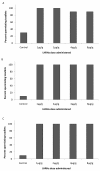Effects of luteinizing hormone-releasing hormone and arginine-vasotocin on the sperm-release response of Günther's Toadlet, Pseudophryne guentheri
- PMID: 21059269
- PMCID: PMC2992061
- DOI: 10.1186/1477-7827-8-139
Effects of luteinizing hormone-releasing hormone and arginine-vasotocin on the sperm-release response of Günther's Toadlet, Pseudophryne guentheri
Abstract
Background: Luteinizing hormone-releasing hormone (LHRH) is an exogenous hormone commonly used to induce spermiation in anuran amphibians. Over the past few decades, the LHRH dose administered to individuals and the frequency of injection has been highly variable. The sperm-release responses reported have been correspondingly diverse, highlighting a need to quantify dose-response relationships on a species-specific basis. This study on the Australian anuran Pseudophryne guentheri first evaluated the spermiation response of males administered one of five LHRHa doses, and second, determined whether AVT administered in combination with the optimal LHRHa dose improved sperm-release.
Methods: Male toadlets were administered a single dose of 0, 1, 2, 4 or 8 micrograms/g body weight of LHRHa. A 4 micrograms/g dose of AVT was administered alone or in combination with 2 micrograms/g LHRHa. Spermiation responses were evaluated at 3, 7 and 12 h post hormone administration (PA), and sperm number and viability were quantified using fluorescent microscopy.
Results: LHRHa administration was highly effective at inducing spermiation in P. guentheri, with 100% of hormone-treated males producing sperm during the experimental period. The number of sperm released in response to 2 micrograms/g LHRHa was greater than all other doses administered and sperm viability was highest in the 1 microgram/g treatment. The administration of AVT alone or in combination with LHRHa resulted in the release of significantly lower sperm numbers.
Conclusion: Overall, results from this study suggest that in P. guentheri, LHRHa is effective at inducing spermiation, but that AVT inhibits sperm-release.
Figures



Similar articles
-
Hormonal induction of gamete release, and in-vitro fertilisation, in the critically endangered southern corroboree frog, Pseudophryne corroboree.Reprod Biol Endocrinol. 2010 Nov 29;8:144. doi: 10.1186/1477-7827-8-144. Reprod Biol Endocrinol. 2010. PMID: 21114857 Free PMC article.
-
Effect of priming injections of luteinizing hormone-releasing hormone on spermiation and ovulation in Gϋnther's toadlet, Pseudophryne guentheri.Reprod Biol Endocrinol. 2011 May 20;9:68. doi: 10.1186/1477-7827-9-68. Reprod Biol Endocrinol. 2011. PMID: 21599916 Free PMC article.
-
Investigating patterns in the spermiation response of eight Australian frogs administered human chorionic gonadotropin (hCG) and luteinizing hormone-releasing hormone (LHRHa).Gen Comp Endocrinol. 2012 Oct 1;179(1):128-36. doi: 10.1016/j.ygcen.2012.08.009. Epub 2012 Aug 15. Gen Comp Endocrinol. 2012. PMID: 22909973
-
Interaction of luteinizing hormone-releasing hormone, cyproterone acetate and arginine vasotocin on plasma levels of luteinizing hormone in intact and castrated adult male rats.Mol Cell Endocrinol. 1979 Apr;14(1):59-71. doi: 10.1016/0303-7207(79)90058-3. Mol Cell Endocrinol. 1979. PMID: 378736
-
Arginine-vasotocin (AVT)--a pineal hormone in mammals.Rom J Endocrinol. 1992;30(1-2):21-44. Rom J Endocrinol. 1992. PMID: 1305517 Review.
Cited by
-
Recovery and Characterization of Spermatozoa in a Neotropical, Terrestrial, Direct-Developing Riparian Frog (Craugastor evanesco) through Hormonal Stimulation.Animals (Basel). 2023 Aug 22;13(17):2689. doi: 10.3390/ani13172689. Animals (Basel). 2023. PMID: 37684953 Free PMC article.
-
The effect of injection and topical application of hCG and GnRH agonist to induce sperm-release in the roseate frog, Geocrinia rosea.Conserv Physiol. 2020 Dec 4;8(1):coaa104. doi: 10.1093/conphys/coaa104. eCollection 2020. Conserv Physiol. 2020. PMID: 33304589 Free PMC article.
-
Hormonal induction of gamete release, and in-vitro fertilisation, in the critically endangered southern corroboree frog, Pseudophryne corroboree.Reprod Biol Endocrinol. 2010 Nov 29;8:144. doi: 10.1186/1477-7827-8-144. Reprod Biol Endocrinol. 2010. PMID: 21114857 Free PMC article.
-
Amphibian reproductive technologies: approaches and welfare considerations.Conserv Physiol. 2021 Mar 16;9(1):coab011. doi: 10.1093/conphys/coab011. eCollection 2021. Conserv Physiol. 2021. PMID: 33763231 Free PMC article.
-
Hormone-induced sperm-release in the critically endangered Booroolong frog (Litoria booroolongensis): effects of gonadotropin-releasing hormone and human chorionic gonadotropin.Conserv Physiol. 2019 Feb 5;7(1):coy080. doi: 10.1093/conphys/coy080. eCollection 2019. Conserv Physiol. 2019. PMID: 30792859 Free PMC article.
References
-
- Rugh R. Experimental embryology: a manual of techniques and proceedures. Minneapolis, Minnesota: Burgess Publishing Company; 1948.
-
- Mann RM, Hyne RV, Choung CB. Hormonal induction of spermiation, courting behaviour and spawning in the Southern Bell Frog, Litoria raniformis. Zoo Biol. 2010;29:1–9. - PubMed
Publication types
MeSH terms
Substances
LinkOut - more resources
Full Text Sources
Miscellaneous

